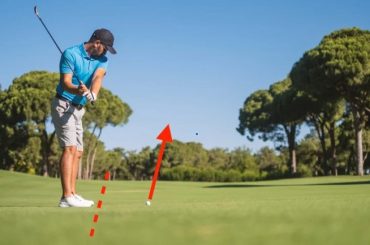The main goal of most of the golfers is to hit a driver consistently throughout a round of golf. You can’t beat the feeling of “crushing” a long tee shot down the fairway, especially where it carries past your playing partners.
From the start, one must know that the driver is the most difficult club in the bag, perhaps matched only by a 1-iron in difficulty. Being between 43 and 45 inches long, it has the longest shaft and creates the widest swing arc. Everything is bound to go wrong with this club, but practice can make it “tame”!
This is our ‘how to hit a driver consistently’ guide…
Right Equipment
The need to use the right equipment in enhancing the overall performance of the player in all areas of the game can never be overemphasized. A driver will hit the ball 14 to 15 times from the tee during a round and a good drive leaves the hole scoring.
Let us get into some detail:
Shaft
In other words, the shaft has to be compatible with the swing speed of the player, to get the best consistent results. The most common mistake of the golfers is choosing the shaft that is “too stiff”.
Flex
The slower the swing speed, the more flex needs to be used in order to produce club head speed through the ball. Direction, control, and distance will be maintained uniformly if selected appropriately. A stiffer shaft for a fast swinger will not flex too much, and shall result controlled flight and distance.
Kick-Point
Where the kick-point falls really counts and such a player should go for a shaft with “low” kick-point in order to help him/her get the clubhead through at the impact point with maximum velocity. This leads to a simple, high launch that results in maximum distance. The opposite is true for the swift swinger that should use a midpoint to high kick-point.
Grip
The grip should also be conveniently- sized to fit the palm size to provide comfort to the hands of the driver.
Loft
The 10 to 10.5 degrees of odd, loft will take the ball to the air, in a positive trajectory and distance, for the average golfer. It is important to realize that the higher loft on the driver, the more control is usually achieved.
Only skilled players should try a driver of 9 and 9,5 degrees. If you must play in a windy, coastal type of course, then a lower ball flight is called for, with the 9 or 9.5-degree being adequate.
Set up For the Driver on the Tee
Before stepping into the stance, perhaps a short analogy would help to realize how crucial the setup is. This is a quote by Johnny Miller, who was a great driver of the ball. In a shooting field with the result, with the riffle, if you do not aim at the target, how do you expect to hit it?
Stance and Alignment
Ideally, the feet should be positioned at a distance of the shoulder between each other and the shoulders and hips should be set parallel to the target line. (think of two parallel train lines) A lot of modern professionals stand open or closed to the ball, according to the shape of shot they intend to play.(more on this later)
Balance
Usually, on the golf course, the player loses balance in the middle of the swing, and the shot is off-target either left or right. A setup should be stable, weight in the “balls” of the feet, but allowing to make the swing preparation by “rocking” back and forth on the heels and toes. However, this is an element of a pre-swing practice. Balance is a big factor in making any movement correctly in any sport.
At Address
Modern large-head drivers require the ball to be teed up high. The concept is to attack the ball through impact and send it out straight and high. In other words, iron should be the “downward” negative angle of attack while driver should be positive.
Considering this, the nut position plays an important role in the correct shooting. However, the opposites instep or just inside the right toe is the point of contact which is on the upswing. Pros position the ball a little up to hit a fade or a little back to hit a draw.
The Swing
Like we said, the driver is the club with the longest shaft, as a result, the longest arc. A player needs to step back a small bit more than with an iron.
Basic Fundamentals to Hit The Driver Consistently:
- Check Alignment
- Be smooth on take off
- Complete the backswing
- Do not over-swing on the backswing
- Concentrate on weight transfer
- Hit through the ball, not at it
- Maintain the swing tempo and rhythm and don’t rush it
- Think swing sequence
Check Alignment
Be sure to always verify the alignment before making the swing. Position yourself behind the ball and pick your landing spot on the fairway. After that, search for a locator like a pitch mark or a blade of grass within a yard ahead of where the ball should be played on the desired line. Now locate the closer marker with your stance and release the shot by executing a swing. Your precision will be ten times greater.
Be Smooth at Take Away
Do not hurry the take-out, as this is the starting movement of the swing. Any abrupt movement will ruin the beat and rhythm.
Complete the Backswing
Since we all know that this is the distance club that starts us off on the hole, there is a tendency to swing faster without finishing the backswing. Pulling the club from the top is bad as the swing sequence is interrupted and the ball can do anything.
Do Not Over-Swing on The Backswing
Attempt to place the shaft of the club at parallel at the top of the swing. It will allow the golfer to have a “connected” feeling throughout the rest of the swing to and through the ball. Collin Marikawa hesitated a little at the very top of his swing.
Concentrate on Weight Transfer
Kick your feet back to the left side and shift your shoulders to the right side of the instep of the left foot without giving you space to start swaying of the ball, the first move of the downswing is to kick the weight back to the left side. The downswing is initiated by the lower body, legs, and hips.
Hitting Through The Ball, Not at it
Focus on pushing the clubhead, not just towards the ball, but through it. End the swing to the left with a complete follow-through.
Maintain The Swing Tempo and Rhythm and Don’t Rush it
No matter what your swing tempo is, make sure it stays controlled with your driver. Attempt to hit it with the same pace as a 7-iron. Control and distance are remarkable.
Think Swing Sequence
The transition between the backswing and the downswing is the hardest single move in golf. The downswing begins with the lower body shifting to the left side and rotation of the hips. Keep the shoulders and arms inactive until this combination is started. They will go down the “slot” and will generate a forceful and tight hit.
These swing thoughts are actually good for all shots except putting. Regrettably, together with the driver, the above are the main faults that make golfers hit the driver inconsistently. It is “the big stick”, and the most fun to hit on the course and also on the range, but don’t hurry with the swing.
How to Hit the Driver Straight (Do you Really Want to Hit it Straight)?
Implementing the guidelines above, will help the golfers to hit that driver straighter and consistently. Nevertheless, the straight shot in golf is also the hardest to hit on every drive.
All golfers have a built in swing bias and pattern when hitting the ball. It is logical to work with this shape regardless if it is a draw or fade. More fairways will be found, as a result, the round is less difficult meaning better scores will be posted.
Under pressure in a game, the golfer should always have a “go-to” shot which is his natural flight shape. Do not look to hit a big hook on the final hole if all he does naturally is fade the ball.
How to Hit a Draw or a Fade?
Simply swinging a fade or a draw with the driver is a straight shot that calls for few adjustments.
Fade
This is the natural shot for most of the golfers and to execute it properly, the left foot should be withdrawn slightly backward from square, which will open up the shoulders and create an out-to-in swing path.
The ball rolls by itself in approbated position. This will impart a lateral spin to the ball and it will curve to the right during the flight. This is the perfectly controlled shot shape, since it lands softer and will not roll to far on the fairway. The clubhead may also be twisted from a square set position at address.
Draw
Drawing is achieved by the converse action with the posture. Lift the right foot back from square and create a slight backward move on the ball in the stance. The clubface can be closed slightly, and now the swing path is inside to out. This generates a side spin that will make the ball go from right to left in the air. The ball releases nicely on the fairway and will gain some distance.
Play the Right Ball
The ball put into play will help in making the driver tee shots more consistent. All golf balls have different compression, and finding the right ball also will help with accuracy and distance on the driver.
A low compression is beneficial to the slow swinger, while the faster swing speed will need a higher compression ball as it will spin less. Spin can be good and bad with the driver, since an excessive amount of spin will cause the ball to “balloon” off the tee and distance will be lost.
On the other hand, the amount of spin is inversely proportional to the time the ball spends in the air under slow swing speed conditions, resulting in the loss of distance. In total, most of the golfers are using a golf ball that is too hard for them to compress and distance is lost.
Range Practice
Seize the chance to go to the range and practice the advice given on how to hit the driver more consistently. Upon these principles being a foundation, minor personal variations must be experimented with to determine the best results. Practice hitting a draw and a fade will improve all-radar ability to negotiate doglegs on the course with more confidence.
More Driver Loft/Shorten the Shaft
For seniors, slow swing speed golfers or those new to the game, a driver with an 11 or 12-degree loft will make it very easy to control and produce lots of “hang time” which is distance. Shaft will be shorter, consistency, control, accuracy and fairways hit will be increased. Graphite shaft ultra-lights will improve clubhead velocity.
Final Thoughts
The power is in making solid drives on the fairway when playing golf. This is the club that we love to hit far with, but far into the trees will cause frustration and take away the fun of the day.
Spend some time to train the basics and create an acronym of the tips for application during a game. Above all, have fun in the game.





